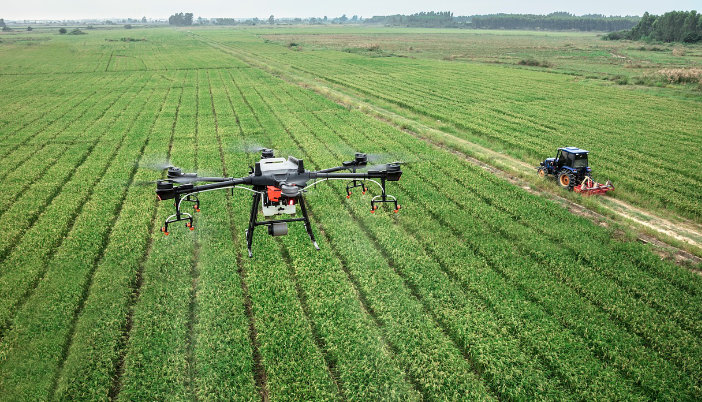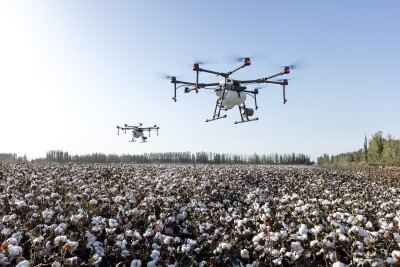Productivity, efficiency, and return on investment (ROI) are always top of mind in any agriculture business. Since manually catering for the heavy-duty and intensive chores of agriculture requires a lot of time and energy, farmers started leaning towards the use of drones to ease these hurdles. According to Fortune Business Insights’ Agriculture Drones Market Global Report, the global agriculture drone market size, valued at $4.17B in 2022, is now projected to grow from $4.98B in 2023 to $18.22B by 2030.
In DroneDeploy’s State of the Drone Industry Report 2022, the company states that farmers claim improvements in operations, as well as planning and design by using drones to digitize their farms. Apart from the obvious advantage of mapping and surveying a farm, drones are also great tools for monitoring crops and livestock, assessing and extracting soil data (all in real-time), smart spraying and seeding/planting, and more. All these benefits lead to enhanced efficiency, advanced accuracy, seamless data collection, increased safety, time-saving, and reduced investments—all of which count towards an increase in ROI.
But how do you measure that ROI? How do you make sure a drone is a benefit and not a hindrance? While a drone might provide all the advantages mentioned above, it doesn’t necessarily mean it’s a pick-up-and-play tool that’s easy to work with. Setting up a drone program requires studying and understanding how a drone may benefit your use case to, in the end, increase ROI.
For example, the choice of a drone depends on the use case at hand—do you require a spraying drone, a drone that can carry multiple payloads, a very high-accuracy mapping drone, or even a drone-in-a-box solution to perform autonomous flights from time to time? Does the drone come with proprietary software, or will you need third-party software? Do you have the necessary hardware to view, manage, and edit the drone-collected data? And on top of that, it’s also important to consider the time it might take to learn and properly analyze that data. If this sounds too complex, maybe consider taking advantage of a drone-as-a-service solution, where a company does all of this for you for a price. These are only some of the questions you need to ask yourself when setting up a drone program to take the first steps into increasing ROI with drones in agriculture.
As the saying goes, “time is money,” so it is important to know if a drone is helping to analyze a farm faster and more efficiently. In an article from Precision Farming Dealer, Bob Recker, owner of Waterloo, Iowa-based Cedar Valley Innovation and a retired engineer from John Deere, shared 17 tips for generating ROI by capturing the most practical value when taking flight with UAVs in agriculture. For instance, Recker recommends setting up a flight path and storing it, “to fly that same pattern over and over, and overlay the images to see how things change over time.” In addition, the “best time of day to fly is 15-20 minutes after sunrise because you get long shadows,” making it easier to identify if a plant is starving, injured, or missing. At high noon, you might not see it at all.
He also states that “when you see a straight line in a field, it is a manmade or equipment problem. Curved lines represent nature—problems with soil, topography, or wind. Typical manmade problems originate when an anhydrous tank ran low, the center of the planter was lighter than the ends, or if there is too much or too little tile in an area.” Finally, “if you can see a problem from the air, there will be a yield impact and it’s usually a negative one—even if it doesn’t later show up on a yield map.”
In 2017, Dusty Wilkins, a farmer from Rupert, Idaho, bought a DJI Phantom 3 and a DroneDeploy subscription to map and regularly scout his fields for signs of plant stress. After a twelve-minute flight at 190 feet altitude above a 26-acre plot, DroneDeploy’s software helped Wilkins to identify what was “the worst aphid infestation” he’d ever seen. Without drone mapping, Wilkins would have to hire a fertilizer agronomist to find the pests, “but at this point of the season, we had full leaf row closure, so walking through the field takes time and it’s really hard. The field man wouldn’t have picked up the infestation for a week,” he said. Because Wilkins caught the infestation before any real damage was done, he got a head start on treatment and prevented significant loss of sugar content to his crop. At $40 per ton, multiplied over 185 acres of beets, he could have been out at least $60,000 in lost revenue. So, in the end, it’s not just about collecting data faster, but also choosing the right payload and the right software to collect reliable data to keep a farm healthy and detect issues beforehand.
Rantizo, a drone spraying service provider, believes spraying drones contribute to a much-quicker ROI when compared to other spraying methods since “it’s not a $500,000-or-more investment.” According to the company, investment in a spraying drone and flying certification comes in at around $40,000-$50,0000. “If you’re making an average of $15 per acre, working five days a week at seven to eight hours per day, running the drone spraying service four to five weeks out of the year, and covering 20 acres per hour, you can recoup that cost in just four to six weeks,” shares Ben Etsinger, a Rantizo regional sales manager. But for a positive ROI, applicators should think about where they can capture the most acres per day since how much they can charge depends on what geography they are servicing—while Iowa-based farms might not pay quite up to $15 an hour, places like Indiana and further east will pay as much as around $20 per acre. In addition, Emily Carlson, director of marketing at Rantizo, believes profit also comes down to how you operate your business, and a smart marketing plan makes the difference in ROI. “I encourage my customers to partner with local, well-respected, and well-followed agronomy consultants that can promote your services to their growers. With a handful of introductions, you’ll likely have more acres than you’re willing to commit to.”
Earlier this year, Bryan Sanders, from HSE, a US full-service provider of commercial and spraying drones, published a video on how to use an ROI & Yield calculator to make money with spraying drones. The three key factors to consider when determining ROI for a spraying drone are:
- How much money will you save using a drone versus a traditional tractor (etc.) in labor and operational costs?
- How much can you increase your yields if you remove tramline losses (fruit drop, etc.) by applying by air instead of on the ground?
- How much can you increase your yields by more frequently or efficaciously treating pests or diseases in your field?
According to Sanders, HSE customers see an increased ROI in their first year due to the significant labor and operational cost savings, depending on the number of acres and frequency of applications.
Jim Fry, a sixth-generation farmer who recently learned about the use of agriculture drones in a pest management workshop, says he was convinced to transition from a tractor to a drone because of its benefits. Reduction in emissions, not having to run tractors and sprayers on fields, reduced compaction for crops that hurt crop growth and production and yields, and better efficiency when it comes to applying sprays when using drones are some of the advantages Fry pointed out. For some farmers, where a drone might replace a tractor, it means a reduction in costs from $500,000 for the tractor down to $150,000 or less for a drone that does the same thing—not to mention maintenance costs.
As the world's second-largest rice exporter, Vietnam’s rice production is primarily supported by small-scale farmers with over 65% of households cultivating under 12 acres. As urbanization and the rising price of fertilizers keep up the pressure, Vietnamese farmers have had to cope with the lack of labor force and higher cost of production. Vietnam's agriculture employment numbers went from around 49% in 2010 to 36% in 2020, and the cost of hiring workers went up 40% when compared to four years ago. Le Thanh Nguyen, a 62-year-old Vietnamese farmer, was no exception to this reality until 2021 when he was introduced to drone technology. By using a XAG-manufactured drone for crop spraying, fertilization, and direct seeding, Nguyen was able to “ease the burden and greatly improve the efficiency.”
“In the past, I had to pay four workers to carry and spread 1 ton of fertilizers on my field from 6 a.m. to 2 p.m., and they were exhausted,” he said. “Also, the drone has the benefits of large-volume, uniform distribution, and high spray penetration, which can help me with better pest control and nutrition management. When feeding nutrients to the rice seeds sown, 100% absorption is achieved by drone spraying whereas only 6 or 7 seeds out of 10 can take in the nutrition if spraying manually.”
Additionally, Nguyen claims he only needs 120kg of seeds to sow 3 acres of rice field by drone, whereas manually he would need 150-200kg to reach the same estimated output. “Spreading by hand or using a traditional sowing machine is likely to result in crop damage and waste of seeds, leading to a yield loss as well as profits,” Nguyen added. “By using the XAG agricultural drone for aerial seeding, such a situation is improved dramatically.”
Bottom line, adopting drone technology for agriculture doesn’t automatically guarantee an increase in ROI, especially if there’s no prior understanding of how a drone might help you reach your goals. Just like Bob Recker said in the Precision Farming Dealer article, “If you aren’t willing to go out, get dirty, and figure out what’s going on, don’t bother. Information that you don’t act on is worthless, it’s just wall art.”
Want more insight on drone-based farming? Attend Commercial UAV Expo to learn more.















Comments